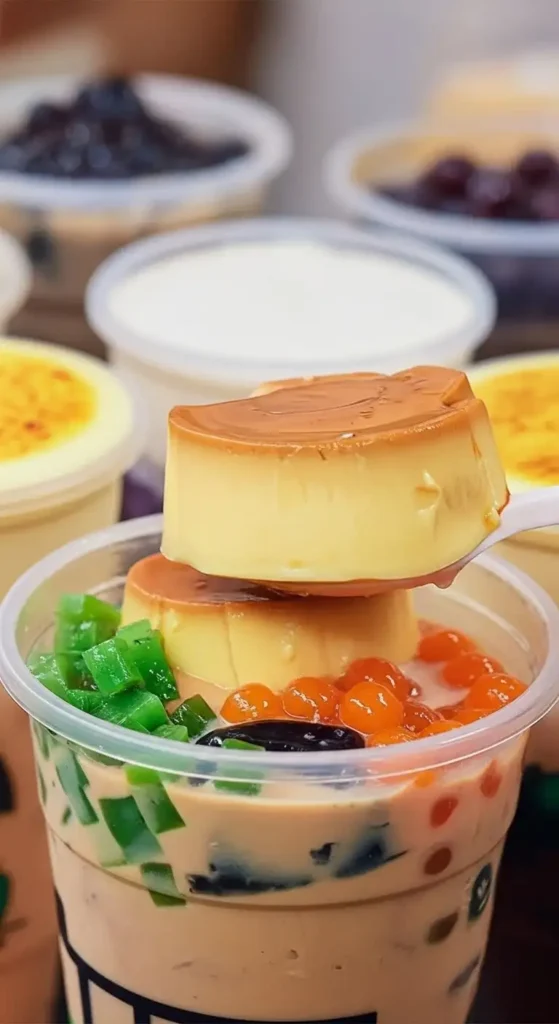Trà Sữa (pronounced trah soo-uh), translating simply to “tea with milk,” is one of the most popular and vibrant beverages in contemporary Vietnam. While globally recognized as “Bubble Tea” or “Boba,” the Vietnamese version has absorbed international trends and infused them with local ingredients and a distinct cultural flair. It’s a national obsession, especially among the youth, and a must-try for any traveler.

The Basics of Trà Sữa
What is it?
Trà Sữa is a sweetened tea drink mixed with milk or creamer and often includes chewy toppings. It is Vietnam’s take on the globally popular milk tea phenomenon that originated in Taiwan.
Key Components:
Tea Base (Trà): Unlike some international versions that use solely black tea, Vietnamese Trà Sữa frequently incorporates local varieties like Jasmine Green Tea (Trà Lài), bold Black Tea (Hồng Trà), or fragrant Oolong Tea (Trà Olong). This use of floral or lighter green teas gives it a distinct Vietnamese aroma.
Milk (Sữa): While fresh milk is common, the traditional Vietnamese sweetness often comes from Sweetened Condensed Milk or a non-dairy creamer, giving it a rich, sometimes slightly fatty, and highly creamy texture.
Toppings (Topping): The classic and most popular topping is chewy Tapioca Pearls (Trân Châu), often sweetened with brown sugar (Đường Đen).
Flavor Profile:
Vietnamese Trà Sữa is characterized by a wonderful balance of creamy sweetness and a discernible tea flavor, which can range from the intense earthiness of black tea to the floral lightness of jasmine. It is always served cold over ice, making it the perfect refreshment for Vietnam’s tropical climate.
Types and Varieties of Trà Sữa
The Vietnamese milk tea scene is an explosion of creativity, moving far beyond the classic pearl milk tea.
| Vietnamese Name | English Translation | Description |
|---|---|---|
| Trà Sữa Trân Châu | Pearl Milk Tea (Boba) | The classic combination of tea, milk, sweetener, and chewy, dark tapioca pearls. This is the baseline. |
| Trà Sữa Khoai Môn | Taro Milk Tea | Made with taro flavoring or taro paste, giving the drink a distinct purple color, a comforting sweetness, and a pleasant, nutty flavor. |
| Trà Sữa Matcha | Matcha Milk Tea | A modern fusion combining the earthy flavor of Japanese matcha with the creamy milk tea base, sometimes paired with brown sugar pearls. |
| Trà Sữa Thạch | Milk Tea with Jelly | This includes various jelly toppings, such as crunchy coconut jelly (Hạt Dừa), coffee jelly, or colorful fruit jellies, often providing a lighter chew than tapioca. |
| Trà Sữa Kem Phô Mai | Cheese Foam Milk Tea | A popular trend featuring a thick, savory-sweet layer of whipped cream cheese foam floating on top of the tea, often enjoyed with Oolong or black tea. |
| Trà Sữa Flan | Flan Milk Tea | A decadent option where a silky, creamy Vietnamese flan cake (Bánh Flan) is added to the milk tea as a topping, creating a dessert-drink hybrid. |

How to Enjoy Trà Sữa
Trà Sữa is less of a formal ritual and more of a social, casual experience, generally enjoyed on the go or while chatting with friends.
Pierce and Sip: Use the signature large, sharp-tipped straw to pierce the plastic seal on the top of the cup. The wide straw is essential for sucking up the chewy toppings along with the liquid.
Chew Your Drink: The entire point of Trà Sữa (especially the Trân Châu version) is the combination of the smooth, sweet liquid and the contrastingly chewy texture of the pearls or jellies. Be prepared to chew a lot!
Customize Your Sweetness: Modern Vietnamese shops offer customizable options for sweetness and ice levels, typically on a scale of 0% to 100%. Don’t be afraid to ask for 70% or 50% sweetness (70% đường or 50% đường) if you prefer a less sugary taste.
Socialize: Trà Sữa is a social beverage. It’s often purchased at a local chain (e.g., Gong Cha, Tocotoco) and enjoyed while sitting on low plastic stools on a busy sidewalk or driving around with friends.
Regional Differences: North, Central, and South
While the core product of Trà Sữa is globally influenced and consistent across modern urban centers, regional differences primarily manifest in the underlying tea and the accompanying café culture.
| Region | Tea Base & Style | Cultural Vibe & Sweetness |
|---|---|---|
| Northern Vietnam (Hanoi, Thai Nguyen) | Strong Tea Preference. The North is a major tea cultivation region (e.g., Thai Nguyen tea). Consequently, Northern Trà Sữa might feature a stronger, more bitter tea base to balance the milk and sugar, resulting in a less overwhelmingly sweet drink. The use of more traditional Vietnamese teas (Green/Jasmine) is still common. | Less Sweet Overall. The café culture is a bit more relaxed, with tea being a centuries-old tradition. |
| Central Vietnam (Da Nang, Hue) | Balanced Flavors. The Central region often acts as a culinary bridge. You'll find a mix of Northern and Southern influences, with the tea flavor being pronounced but often paired with rich, creative toppings. The city of Bao Loc in the Central Highlands is a key tea-growing area, influencing quality. | Balanced Sweetness. Focus on quality of tea from nearby highlands. |
| Southern Vietnam (Ho Chi Minh City/Saigon) | Sweet and Decadent. Southern cuisine generally favors more sweetness. Trà Sữa in the South is often richer, creamier, and the sweetest of the three regions, with a strong focus on toppings. Shops often feature the latest, most elaborate trends, such as Cheese Foam and layered fruit teas. | Very Sweet and Creative. The fastest-paced and most competitive market for new flavor innovations. |




